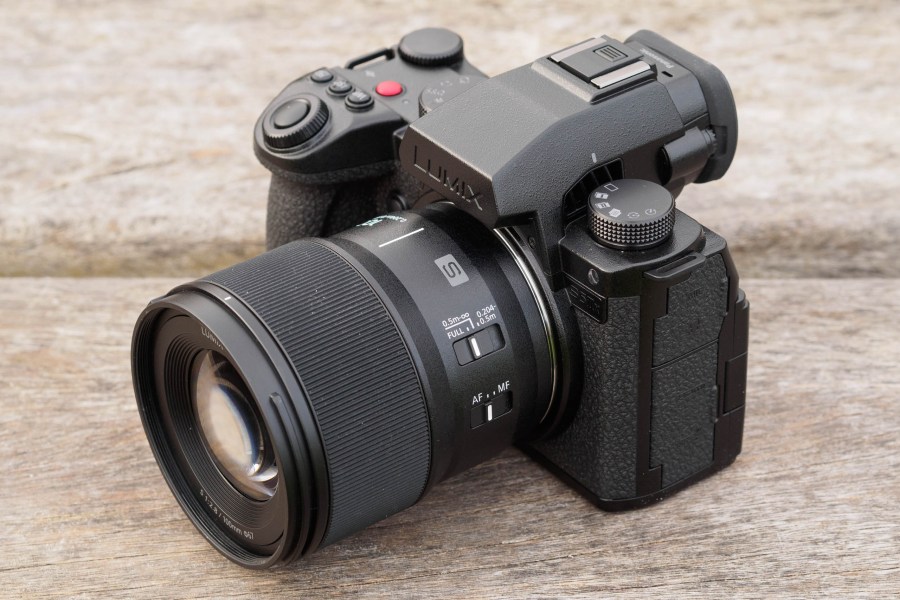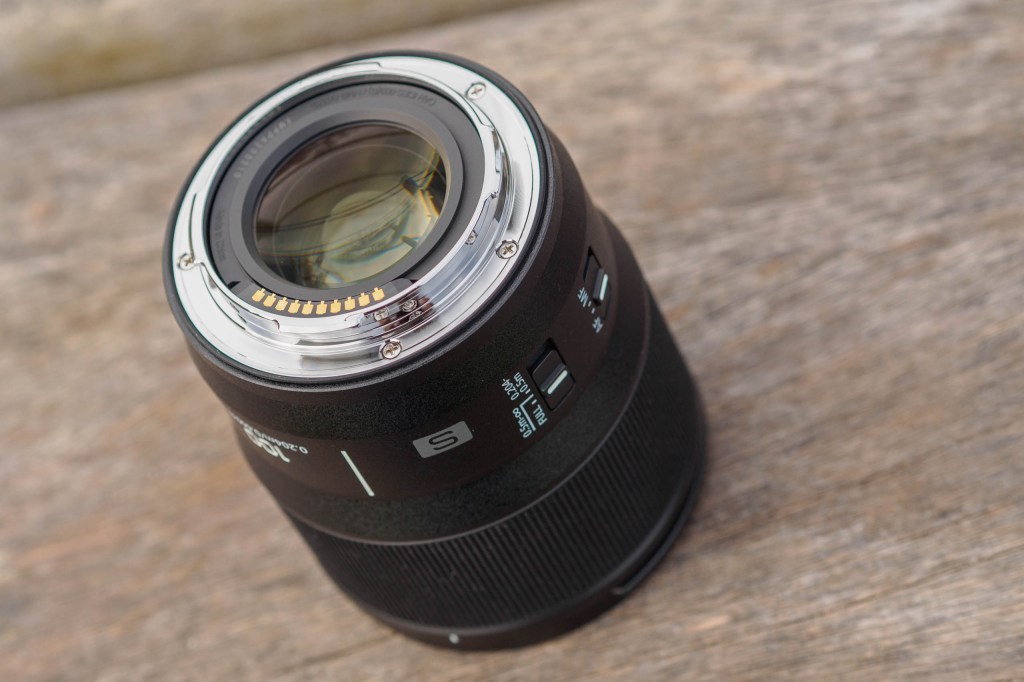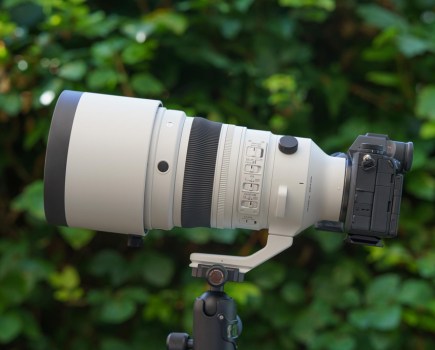Panasonic has been making full-frame mirrorless for just as long as Canon and Nikon, having been a founding member of the L-Mount Alliance in 2018. While it initially struggled for market traction, its Lumix S5II and S5IIX cameras have provided considerable impetus to the system. Now the firm has launched another eye-catching product – the implausibly compact Panasonic Lumix S 100mm F2.8 Macro.
Designed for shooting close-ups, this is, by a considerable margin, the smallest and lightest lens of its type. It’s just 8.2cm long and weighs less than 300g, which means it’s exactly the same size, and very similar in weight, to Panasonic’s highly regarded f/1.8 primes. In contrast, its closest L-mount competitor, the Sigma 105mm F2.8 DG DN Macro, measures 13.4cm and 715g, which is pretty typical for its class.
Despite its tiny size, the Lumix 100mm is still capable of life-size magnification – in other words, filling the frame with a subject measuring 36 x 24mm on a full-frame camera. Its 100mm short-telephoto focal length means it can also double up as a handy portrait lens for photographing people.

The Lumix 100mm F2.8 is two-thirds of the length, and less than half the weight, of other comparable optics. Credit: Andy Westlake
Unsurprisingly, the Lumix lens is more expensive than the Sigma, at £1000 compared to £699. But that’s not dissimilar to other camera makers’ equivalent optics; for example, the Nikon Nikkor Z MC 105mm f/2.8 VR S is £1049. So on paper, everything points to you getting a fully-fledged macro lens, but in a package that’s less than half the usual weight, and two-thirds of the size. So what, if anything, is the catch?
Panasonic Lumix S 100mm F2.8 Macro: Features
Panasonic has employed an optical design with 13 elements in 11 groups, which at first sight is simpler than rival lenses. However, the firm has made extensive use of special elements, including three aspherical elements, two made from extra-low dispersion (ED) glass, and one from ultra-low dispersion (ED) glass. Together, these are designed to maintain sharpness from corner to corner while suppressing any colour fringing.
The aperture diaphragm is formed of nine curved blades. They maintain a nicely rounded shape at larger openings, with the aim of delivering attractive bokeh. It provides settings as small as f/22, and while some macro lenses stop down further, this inevitably comes with a considerable loss of sharpness due to diffraction. As with other Lumix S lenses, there’s no aperture control ring on the barrel.
Autofocus is handled by a new ‘dual phase linear motor’, which Panasonic says is a key factor in its compact design. Watching how the lens elements move during focusing reveals that, unusually, this one has two focus groups moving in opposite directions. Most macro lenses work by moving a single, relatively large optical group back and forth.
At 1:1 magnification, the minimum focus distance is just 20.4cm. This is somewhat shorter than comparable lenses, which tend to be around 29cm. The result is an unusually close working distance between the front of the lens and the subject of about 10cm, compared to 14cm for the Sigma 105mm f/2.8.
That’s not necessarily a good thing; it means you’re that bit more likely to get in your own light, or to disturb twitchy subjects. But while it’s something to be aware of, for most people it shouldn’t be a deal-breaker.
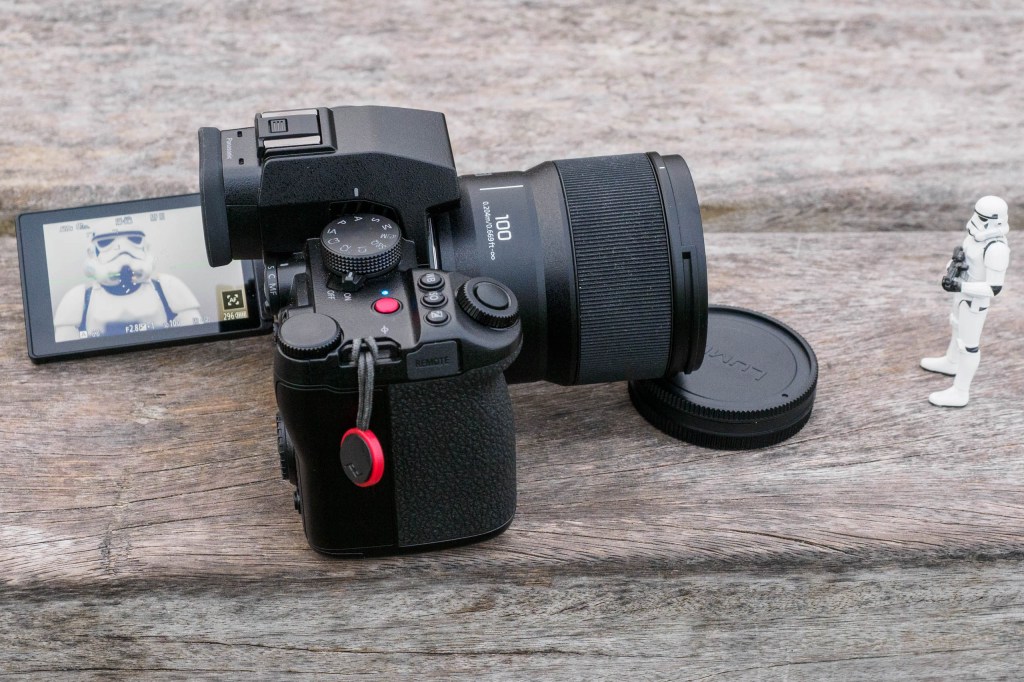
The working distance between the front of the lens and the subject is about 10cm at the closest focus. Credit: Andy Westlake
A deep cylindrical hood provides protection for the front element against both stray light and physical impact. It includes a push-button lock to prevent it from falling off accidentally, and reverses for storage. Like many other Panasonic Lumix S lenses, the filter thread is 67mm.
Panasonic Lumix S 100mm F2.8 Macro: Build and Handling
Thanks to its petite dimensions and light weight, the Lumix S 100mm F2.8 Macro handles somewhat differently to other lenses in its class. I tested it using the 24MP Panasonic Lumix S5IIX camera and found the two made a very agreeable combination. It’s just that bit better balanced on the camera than other short-telephoto macro lenses, which tend to feel slightly front heavy.
One of the ways Panasonic has kept the weight down is to use a plastic skin for the barrel. But this doesn’t mean the lens feels cheap. Instead, it’s very similar in terms of styling and finish to the firm’s other L-mount lenses, including those f/1.8 primes and the 20-60mm kit zoom.
Despite its light weight, the lens still boasts dust- and splash-resistant construction, including a seal around the mount to protect the camera body. It’s also designed to be freezeproof to -10°C. This is good news, given that it’s likely to be used outdoors often.

Controls are limited to the large manual focus ring, plus focus mode and distance limiter switches. Credit: Andy Westlake
At the front of the barrel, you’ll find a large manual focus ring, which is electronically coupled and rotates smoothly with no hard end stops. By default, it operates in a non-linear fashion, meaning that the quicker you turn the focus ring, the more rapidly the focus distance changes. With some cameras you can switch to a linear focusing response, which personally I prefer, and used on the S5IIX.
The only other controls are two switches on the side. One selects between autofocus and manual, while the other can be used to limit the focus distance range, either within the macro range (50cm – 20.4cm), or for subjects further than 50cm. This can be useful to reduce autofocus hunting.
Panasonic Lumix S 100mm F2.8 Macro: Autofocus
One area where the Lumix S 100mm F2.8 Macro excels is with regards to autofocus. Traditionally, this has been a weak point of macro lenses, as they often have to move large focus groups over long distances. But that’s not the case here, with the lens instead focusing impressively quickly and consistently accurately.

Autofocus is rapid enough for quick grab shots. This is a 6MP crop (200mm equivalent). Credit: Andy Westlake
Unlike most older macro lenses, this one also acquits itself well when shooting moving subjects in AF-C mode. You might still be better off with the likes of a 70-200mm zoom for fast, unpredictable action, but the 100mm should be able to keep up very well with less demanding situations, such as portrait photography.
Photographers often think it’s necessary to use manual focus for macro shooting, but that’s no longer necessarily true, and autofocus is entirely usable almost all the time. If you engage the Pinpoint Focus setting on a Panasonic camera, you can position the focus area exactly where you want, and then autofocus perfectly accurately. Alternatively, you can press the AF-ON button even when using manual focus mode, and again autofocus exactly at your selected point within the scene.
Of course, you can still use manual focus if you prefer – it often works very well for slow, considered close-up shooting. Again, the lens is very well behaved, making it easy to get the sharpest focus exactly where you want.
Those who like to shoot video will be delighted to find that the autofocus is extremely quiet, so it shouldn’t disturb your soundtrack. Likewise, focus breathing is suppressed very effectively at longer subject distances, down to about 1.5m. Once you get into the macro range, though, the angle of view narrows considerably on focusing closer. But that’s usually true with macro lenses.
Panasonic Lumix S 100mm F2.8 Macro: Performance
We expect macro lenses to be impeccably behaved when it comes to optical quality, and that’s essentially what I saw from the Lumix 100mm f/2.8. Image files are packed full of detail, with no troublesome aberrations. Out-of-focus areas are handled nicely, too.

Images are packed full of detail from corner to corner. Credit: Andy Westlake
Tested on the 24MP Lumix S5IIX, the lens resolves impressive levels of detail from corner to corner, even wide open at f/2.8. It gets a little crisper on stopping down to f/4 or f/5.6, if you stare closely at your image files onscreen, but the difference isn’t huge. Close the aperture past f/8, and diffraction progressively blurs away pixel-level detail. But this doesn’t stop the lens from being eminently usable at f/22 if you need extended depth of field.
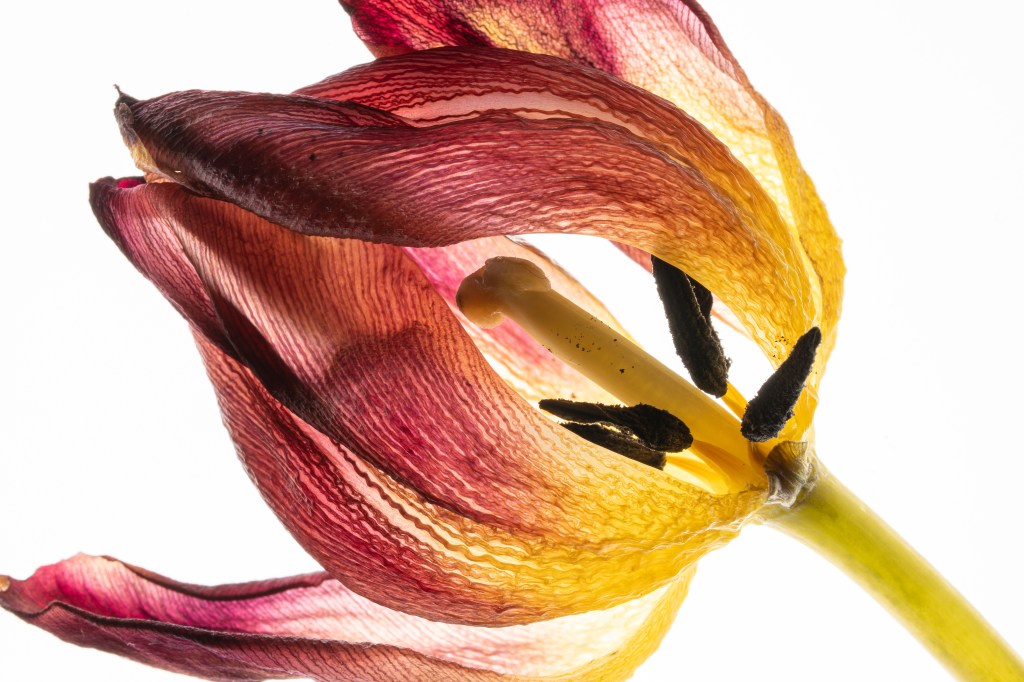
There’s no problem shooting at f/22 when you need extended depth-of-field, especially with a little added sharpening. Credit: Andy Westlake
With this kind of lens, we’re just as much concerned with the way it renders out-of-focus areas of the image, as those that are sharp. In this respect, the Lumix 100mm f/2.8 acquits itself admirably for both close-up and portrait shooting. Backgrounds are, in general, attractively rendered, while transitions between sharp and blurred areas are handled in a smooth and natural-looking fashion, too.

Transitions to out-of-focus regions are nice and smooth. Credit: Andy Westlake
If you’re primarily interested in photographing people, the Lumix S 85mm F1.8 would probably still be the better choice. It should certainly deliver a greater degree of background blur. However, the 100mm f/2.8 will also do a really nice job.

The lens also does a very nice job of shooting portraits, with attractive bokeh. credit: Andy Westlake
I saw barely any hint of colour fringing, either in the corners due to lateral chromatic aberration, or in out-of-focus regions at large apertures due to the longitudinal variety. There’s a little in the way of corner darkening at f/2.8, but this will often be a positive thing, as it helps frame your subject. It essentially goes away at f/4, too.

There’s some vignetting at f/2.8, but it’s not at all problematic, and with many natural subjects you won’t really see it. Credit: Andy Westlake
Examining uncorrected raw files does, however, give another clue as to how Panasonic has achieved the lens’s tiny size. It exhibits visible pincushion distortion that needs to be corrected in software. This wouldn’t have been acceptable on a macro lens designed for film, as these were expected to give perfectly corrected images. But the world has moved on now, and every image taken with this lens will have to be software processed anyway, so it’s really only of academic note.

Image quality holds up really well over the full distance range: this is at life-size magnification. Credit: Andy Westlake
Operationally, you’ll still see a geometrically corrected image in the viewfinder, while out-of-camera JPEGs are automatically corrected, too. The requisite correction parameters are also embedded into the raw files and applied automatically by Adobe software. Most users won’t even be aware this is happening, let alone care – they’ll just get sharp, clean images with straight lines where they should be.

Images are clean and unaffected by flare or chromatic aberration. Credit: Andy Westlake
The lens also deals very well with shooting into the light. I saw no problematic loss of contrast due to flare, and nothing to worry about with regards to ghosting with bright light sources in the frame. Overall, the optical performance is pretty much exemplary.
Panasonic Lumix S 100mm F2.8 Macro: Verdict
I’m a big fan of short-telephoto macro lenses, and the Panasonic Lumix S 100mm F2.8 Macro is an excellent example. I really appreciated its small size and light weight; getting 1:1 magnification on full-frame from such a portable lens is a revelation. Other compact macro lenses have shorter focal lengths, which usually equates to awkwardly tight working distances and less attractive perspective. Crucially, I was also delighted by the image quality it delivered.
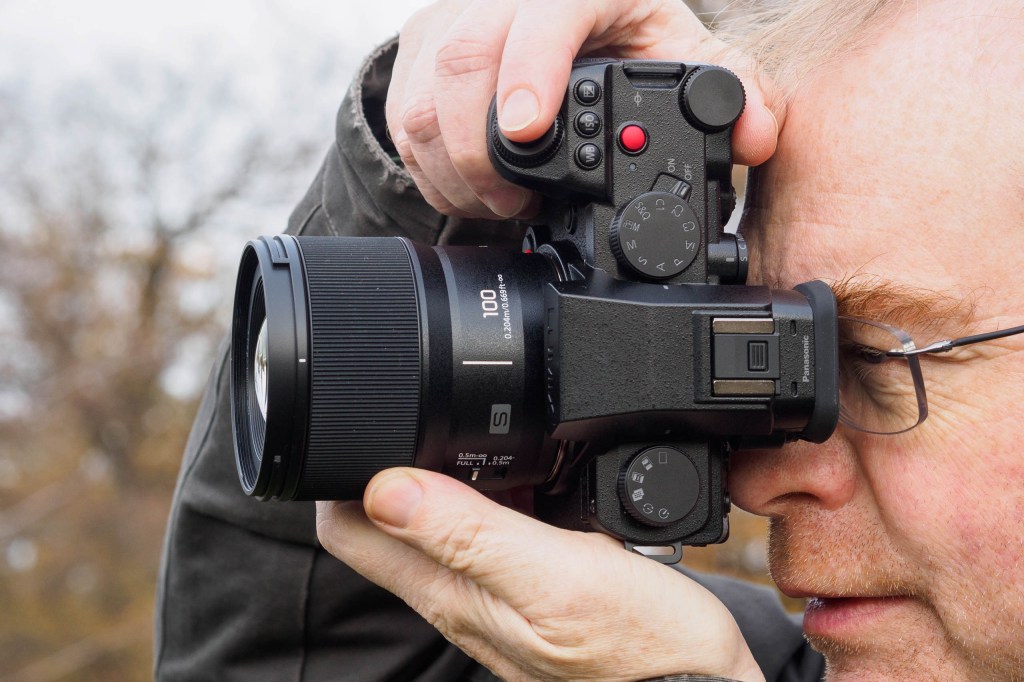
Panasonic has made a remarkably small full-frame macro lens with no obivous real-world compromise. Credit: Andy Westlake
As for compromises, there’s barely anything to worry about. The working distance is a little close compared to its peers, which means the Sigma 105mm F2.8 DG DN might be a better choice for L-mount users photographing skittish subjects such as insects. It’s also possible that some of the more obscure raw converters won’t deal properly with the required distortion correction. But for most users, neither should be a major problem.

In-body stabilisation in Panasonic’s Lumix S cameras makes up for the lack of in-lens optical stabilisation. I shot this hand-held at 1/8 second – it just took a few attempts. Credit: Andy Westlake
Overall, the Lumix S 100mm F2.8 Macro is a fantastic lens from Panasonic that completely redefines what a short telephoto macro can look like. It’s just so much easier to drop into your bag and carry around with you than any comparable optic, and there’s no obvious compromise in terms of optical quality. If I were an L-mount user, I’d buy one in a heartbeat.

Follow AP on Facebook, Twitter, Instagram, and YouTube.

